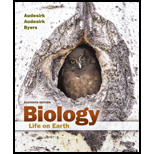
Biology: Life on Earth (11th Edition)
11th Edition
ISBN: 9780134168296
Author: Gerald Audesirk, Teresa Audesirk, Bruce E. Byers
Publisher: PEARSON
expand_more
expand_more
format_list_bulleted
Textbook Question
Chapter 2, Problem 5FTB
Water is described as _____ because each water molecule has slightly negative and positive poles. This property allows water molecules to form ______ bonds with one another. The bonds between water molecules give water a high _______ that produces surface tension.
Expert Solution & Answer
Want to see the full answer?
Check out a sample textbook solution
Students have asked these similar questions
What is the concept "calories consumed must equal calories burned" in regrads to nutrition?
You intend to insert patched dominant negative DNA into the left half of the neural tube of a chick.
1) Which side of the neural tube would you put the positive electrode to ensure that the DNA ends up on the left side?
2) What would be the internal (within the embryo) control for this experiment?
3) How can you be sure that the electroporation method itself is not impacting the embryo?
4) What would you do to ensure that the electroporation is working? How can you tell?
Describe a method to document the diffusion path and gradient of Sonic Hedgehog through the chicken embryo. If modifying the protein, what is one thing you have to consider in regards to maintaining the protein’s function?
Chapter 2 Solutions
Biology: Life on Earth (11th Edition)
Ch. 2 - 1. Which of the following is false?
a. An element...Ch. 2 - Prob. 2MCCh. 2 - Isotopes are defined as a. atoms of the same...Ch. 2 - Molecules a. always consist of different elements...Ch. 2 - 5. Covalent bonds
a. link water molecules in...Ch. 2 - 1. An atom consists of an atomic nucleus composed...Ch. 2 - Prob. 2FTBCh. 2 - Prob. 3FTBCh. 2 - An atom with an outermost electron shell that is...Ch. 2 - Water is described as _____ because each water...
Ch. 2 - Based on Table 2–1 how many neutrons are there in...Ch. 2 - 2. Distinguish between atoms and molecules and...Ch. 2 - 3. Compare and contrast covalent bonds and ionic...Ch. 2 - 4. Explain how polar covalent bonds allow hydrogen...Ch. 2 - Why can water absorb a great amount of heat with...Ch. 2 - 6. Describe how water dissolves a salt.
Ch. 2 - Define pH scale, acid, base, and buffer. How do...Ch. 2 - Prob. 1ACCh. 2 - Prob. 2ACCh. 2 - You can now buy “whiskey stones” made of granite,...
Knowledge Booster
Learn more about
Need a deep-dive on the concept behind this application? Look no further. Learn more about this topic, biology and related others by exploring similar questions and additional content below.Similar questions
- The following table is from Kumar et. al. Highly Selective Dopamine D3 Receptor (DR) Antagonists and Partial Agonists Based on Eticlopride and the D3R Crystal Structure: New Leads for Opioid Dependence Treatment. J. Med Chem 2016.arrow_forwardThe following figure is from Caterina et al. The capsaicin receptor: a heat activated ion channel in the pain pathway. Nature, 1997. Black boxes indicate capsaicin, white circles indicate resinferatoxin. You are a chef in a fancy new science-themed restaurant. You have a recipe that calls for 1 teaspoon of resinferatoxin, but you feel uncomfortable serving foods with "toxins" in them. How much capsaicin could you substitute instead?arrow_forwardWhat protein is necessary for packaging acetylcholine into synaptic vesicles?arrow_forward
- 1. Match each vocabulary term to its best descriptor A. affinity B. efficacy C. inert D. mimic E. how drugs move through body F. how drugs bind Kd Bmax Agonist Antagonist Pharmacokinetics Pharmacodynamicsarrow_forward50 mg dose of a drug is given orally to a patient. The bioavailability of the drug is 0.2. What is the volume of distribution of the drug if the plasma concentration is 1 mg/L? Be sure to provide units.arrow_forwardDetermine Kd and Bmax from the following Scatchard plot. Make sure to include units.arrow_forward
- Choose a catecholamine neurotransmitter and describe/draw the components of the synapse important for its signaling including synthesis, packaging into vesicles, receptors, transporters/degradative enzymes. Describe 2 drugs that can act on this system.arrow_forwardThe following figure is from Caterina et al. The capsaicin receptor: a heat activated ion channel in the pain pathway. Nature, 1997. Black boxes indicate capsaicin, white circles indicate resinferatoxin. a) Which has a higher potency? b) Which is has a higher efficacy? c) What is the approximate Kd of capsaicin in uM? (you can round to the nearest power of 10)arrow_forwardWhat is the rate-limiting-step for serotonin synthesis?arrow_forward
arrow_back_ios
SEE MORE QUESTIONS
arrow_forward_ios
Recommended textbooks for you
 Concepts of BiologyBiologyISBN:9781938168116Author:Samantha Fowler, Rebecca Roush, James WisePublisher:OpenStax College
Concepts of BiologyBiologyISBN:9781938168116Author:Samantha Fowler, Rebecca Roush, James WisePublisher:OpenStax College Biology Today and Tomorrow without Physiology (Mi...BiologyISBN:9781305117396Author:Cecie Starr, Christine Evers, Lisa StarrPublisher:Cengage Learning
Biology Today and Tomorrow without Physiology (Mi...BiologyISBN:9781305117396Author:Cecie Starr, Christine Evers, Lisa StarrPublisher:Cengage Learning Human Biology (MindTap Course List)BiologyISBN:9781305112100Author:Cecie Starr, Beverly McMillanPublisher:Cengage Learning
Human Biology (MindTap Course List)BiologyISBN:9781305112100Author:Cecie Starr, Beverly McMillanPublisher:Cengage Learning

Concepts of Biology
Biology
ISBN:9781938168116
Author:Samantha Fowler, Rebecca Roush, James Wise
Publisher:OpenStax College

Biology Today and Tomorrow without Physiology (Mi...
Biology
ISBN:9781305117396
Author:Cecie Starr, Christine Evers, Lisa Starr
Publisher:Cengage Learning

Human Biology (MindTap Course List)
Biology
ISBN:9781305112100
Author:Cecie Starr, Beverly McMillan
Publisher:Cengage Learning



GCSE Chemistry - Acids and Bases #34; Author: Cognito;https://www.youtube.com/watch?v=vt8fB3MFzLk;License: Standard youtube license